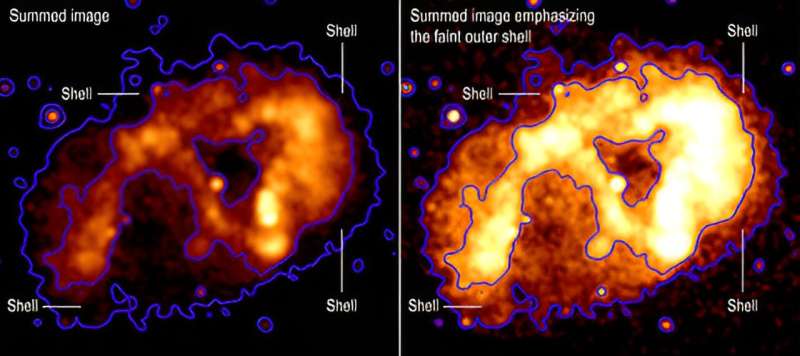This article has been reviewed according to Science X's editorial process and policies. Editors have highlighted the following attributes while ensuring the content's credibility:
fact-checked
peer-reviewed publication
trusted source
proofread
NASA's Chandra rewinds story of great eruption of the 1840s

Using snapshots taken over 20 years with NASA's Chandra X-ray Observatory, astronomers have learned important new details about an eruption from Eta Carinae witnessed on Earth in the mid-19th century.
Chandra data spanning decades has been combined into a new movie that contains frames of Eta Carinae from 1999, 2003, 2009, 2014, and 2020. Astronomers used the Chandra observations, along with data from ESA's (European Space Agency's) XMM-Newton, to watch as the stellar eruption from 180 years ago continues to expand into space at speeds up to 4.5 million miles per hour. The new insights gleaned from Eta Carinae show how different space observatories can work together to help us understand changes in the universe that unfold on human timescales.
A paper describing these results appears in The Astrophysical Journal.
Eta Carinae is a system that contains two massive stars (one is about 90 times the mass of the sun and the other is believed to be about 30 times the sun's mass). In the middle of the 19th century, Eta Carinae was observed to experience a huge explosion that astronomers have dubbed the "Great Eruption." During this event, Eta Carinae ejected between 10 and 45 times the mass of the sun. This material became a dense pair of spherical clouds of gas, now called the Homunculus Nebula, on opposite sides of the two stars.
A bright ring of X-rays around the Homunculus Nebula was discovered about 50 years ago and studied in previous Chandra work. The new movie from Chandra, plus a deep image generated by adding the data together, reveal important hints about Eta Carinae's volatile history, including rapid expansion of the ring and a previously unknown faint shell of X-rays outside it.
"We've interpreted this faint X-ray shell as the blast wave from the Great Eruption in the 1840s," said Michael Corcoran at NASA's Goddard Space Flight Center in Greenbelt, Maryland, who led the study. "It tells an important part of Eta Carinae's backstory that we wouldn't otherwise have known."
Because the newly discovered outer X-ray shell has a similar shape and orientation to the Homunculus Nebula, Corcoran and his colleagues think both structures have a common origin.
The idea is that material was blasted away from Eta Carinae well before the 1843 Great Eruption—sometime between 1200 and 1800, based on the motion of clumps of gas previously seen in data from NASA's Hubble Space Telescope. Later, the fast blast wave from the Great Eruption tore through space, colliding with and heating the clumps to millions of degrees to create the bright X-ray ring. The blast wave has now traveled beyond the bright ring.
"The shape of this faint X-ray shell is a plot twist in my mind," said co-author Kenji Hamaguchi, a researcher at the University of Maryland, Baltimore County, and NASA Goddard. "It shows us that the faint shell, the Homunculus, and the bright inner ring likely all come from eruptions from the star system."
With XMM-Newton, the researchers saw that the X-ray brightness of Eta Carinae has faded with time, agreeing with previous observations of the system obtained with NASA's Neutron Star Interior Composition Explorer (NICER) telescope on the International Space Station. The authors applied a simple model to estimate how bright Eta Carinae was in X-rays at the time of the Great Eruption and combined this with the speed of the material—determined from the movie—to estimate how quickly the high-speed gas was ejected.
The researchers combined this information with an estimate of how much gas was ejected to determine that the Great Eruption likely consisted of two explosions. There was a first, quick ejection of a small amount of fast, low-density gas which produced the X-ray blast wave. This was followed by the slower ejection of dense gas that eventually formed the Homunculus Nebula.
A team led by Nathan Smith of the University of Arizona, one of the co-authors of the new X-ray study, has previously suggested that the Great Eruption was caused by the merger of two stars, in what was originally a triple system. This would also explain the ring-like structure seen in X-rays because it would cause material to be ejected in a flat plane.
"The story of Eta Carinae just keeps getting more interesting," said Smith. "All evidence is suggesting that Eta Carinae survived a very powerful explosion that would normally obliterate a star. I can't wait for the next episode of data to find out what other surprises Eta Carinae has in store for us."
More information: Michael F. Corcoran et al, The Expansion of the X-Ray Nebula Around η Car, The Astrophysical Journal (2022). DOI: 10.3847/1538-4357/ac8f27
Journal information: Astrophysical Journal
Provided by NASA




















